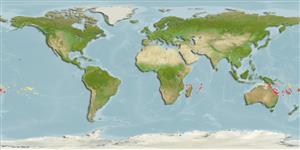>
Ovalentaria/misc (Various families in series Ovalentaria) >
Pomacentridae (Damselfishes) > Pomacentrinae
Etymology: Amphiprion: Greek, amphi = on both sides + Greek, prion, -onos = saw (Ref. 45335).
Environment: milieu / climate zone / depth range / distribution range
экология
морской ассоциированный с рифами; немигрирующий; пределы глубины 1 - 25 m (Ref. 7247). Subtropical; 10°S - 32°S
Western Pacific: eastern Australia (Great Barrier Reef and Coral Sea, northern New South Wales), New Caledonia, and Loyalty Islands. Recently reported from Tonga (Ref. 53797).
Size / Вес / Возраст
Maturity: Lm ? range ? - ? cm
Max length : 9.0 cm SL самец/пол неопределен; (Ref. 7247)
колючие лучи спинного плавника (общее число): 10 - 11; членистые (мягкие) лучи спинного плавника (общее число): 14-17; колючие лучи анального плавника 2; членистые (мягкие) лучи анального плавника: 13 - 14. Body and head orange with two black-edged white bars; the first running from the top of the head across the face, just behind the eye; the second from the mid portion of the dorsal fin. Caudal peduncle and caudal fin white.
Life cycle and mating behavior
половая зрелость | размножение | нерест | икра | Fecundity | личинки
Oviparous, distinct pairing during breeding (Ref. 205). Eggs are demersal and adhere to the substrate (Ref. 205). Males guard and aerate the eggs (Ref. 205). Also Ref. 7471.
Allen, G.R., 1991. Damselfishes of the world. Mergus Publishers, Melle, Germany. 271 p. (Ref. 7247)
Статус Красного Списка МСОП (Ref. 130435)
Угроза для людей
Harmless
Использование человеком
аквариум: коммерческий
дополнительная информация
ссылкиаквакультура (рыбоводство)особенности рыбоводствастепень растяжениягенетикаElectrophoresesнаследуемостьболезниобработкаNutrientsMass conversion
инструменты
Специальные отчеты
Скачать в формате XML
ресурсы в Интернет
Estimates based on models
Preferred temperature (Ref.
123201): 24.6 - 27.9, mean 26.4 °C (based on 559 cells).
Phylogenetic diversity index (Ref.
82804): PD
50 = 0.5000 [Uniqueness, from 0.5 = low to 2.0 = high].
Bayesian length-weight: a=0.02455 (0.01556 - 0.03872), b=2.96 (2.83 - 3.09), in cm total length, based on LWR estimates for this species & (Sub)family-body (Ref.
93245).
Trophic level (Ref.
69278): 2.7 ±0.29 se; based on food items.
устойчивость к внешним воздействиям (Ref.
120179): высокий, минимальное время удвоения популяции до 15 месяцев (Preliminary K or Fecundity.).
Fishing Vulnerability (Ref.
59153): Low vulnerability (10 of 100).
Nutrients (Ref.
124155): Calcium = 81.6 [33.8, 152.1] mg/100g; Iron = 0.775 [0.439, 1.462] mg/100g; Protein = 18.8 [17.6, 20.1] %; Omega3 = 0.177 [0.093, 0.330] g/100g; Selenium = 10.6 [4.7, 22.7] μg/100g; VitaminA = 62.5 [14.7, 244.4] μg/100g; Zinc = 1.28 [0.77, 2.03] mg/100g (wet weight);
